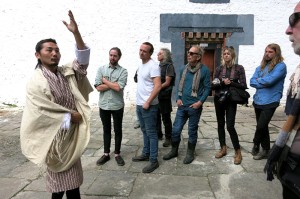BHUTANESE TOUR GUIDES SAY NO TO TOURISTS’ TARIFF LIBERALISATION
Guides against tariff liberalization
A majority of about 100 guides who attended a discussion on issues and challenges in the guiding profession yesterday wanted the current system including the tariff to remain the same.
The Guides Association of Bhutan (GAB) organized the meeting to discuss the National Council’s recommendations on tourism particularly the tariff liberalization, standardization, daily allowance and training opportunities for guides, among others.
Discussions on tariff dominated the forum and despite requests to take turns, all guides spoke at the same time.
GAB chairman Garab Dorji said that, personally, he felt it was time for some reform in the industry to bring about healthy competition in the market.
Last year’s international tourist arrivals of 58,022, he said translates to 12,000 groups. “This means that each guide, on an average catered to about four groups,” he said.
This indicates that a guide was employed only for a month, he said, which means guides are unemployed going by the labour force definition of employed. “It becomes a part time job,” he said.
GAB’s former executive director Sangay Phurba who is now a trainer said while it would be easy to liberalize, the reality would be different. If the issue was about undercutting, he said the government gets its taxes and royalty. “Technically, there is no undercutting,” he said, adding there are few cases but that’s business. “How sure are we to be employed if liberalized?”
A specialized guide Dr Norbu Wangchuk said he was for liberalization, as the country’s economy did not benefit much in the current system. “The overseas travel agents sell Bhutan for USD 500 to 600 but the money doesn’t enter our economy,” he said.
With liberalization, he said regional tourists would balance the tariff paying tourists. “Going by the increase in regional tourists, it won’t be long before the unregulated regional tourists overtake international tourists,” he said, emphasizing the existing issues of regional tourists.
If liberalized, he said that GAB could take the lead role in categorizing guides based on experience and market.
The guides agreed on the need to set a minimum base rate for guides based on which tour operators could “top up” depending on a guide’s expertise. The guides also requested that they be paid as per the clientele, specialization and experience.
Guides are paid Nu 500 to Nu 1,500 a day during peak season while during lean seasons they earn about Nu 500 to 1,000.
Guides said they have been paid the same amount since they joined the industry and the limited allowance was not enough to cover food and accommodation, unless its provided for free.
A guide said the government proudly claims that the unemployment rate has been reduced when the reality is different. He said the labour ministry must step in to address the issue of freelancing by providing stipend until they are permanently employed.
The issue of unregulated regional tourists and lack of training opportunities for guides to enhance their skills also came up for discussion.
Senior guides said there were training opportunities for guides until 2000 after which it was done away with. Guides also agreed to propose authorities to ensure that all regional tourists avail guides.
With about 640 guides entering the industry every year, a guide said it was a concern while another suggested that training institutes stop producing more guides so as not to affect employment opportunities. “Currently, guides are produced like chips from a factory,” a guide said.
Sangay Phurba said just because there are unemployed graduates or trained teacher today don’t mean that the colleges close shop. “This is not how it works, it’s a free market and the same applies to the rest of us,” he said.
There are more than 2,700 licensed guides today.
SOURCE: KUENSEL








